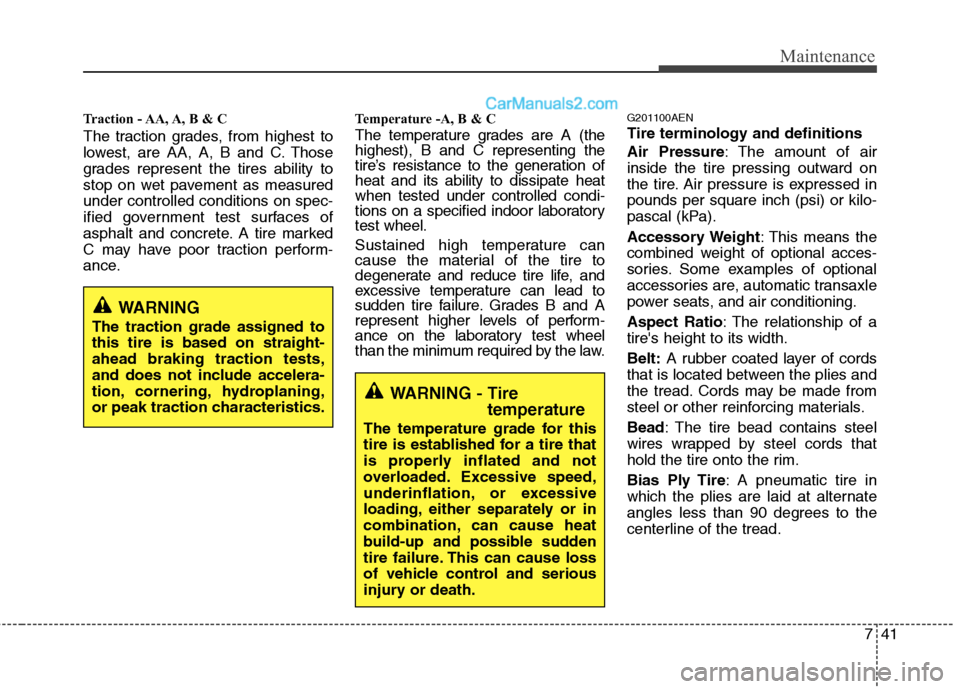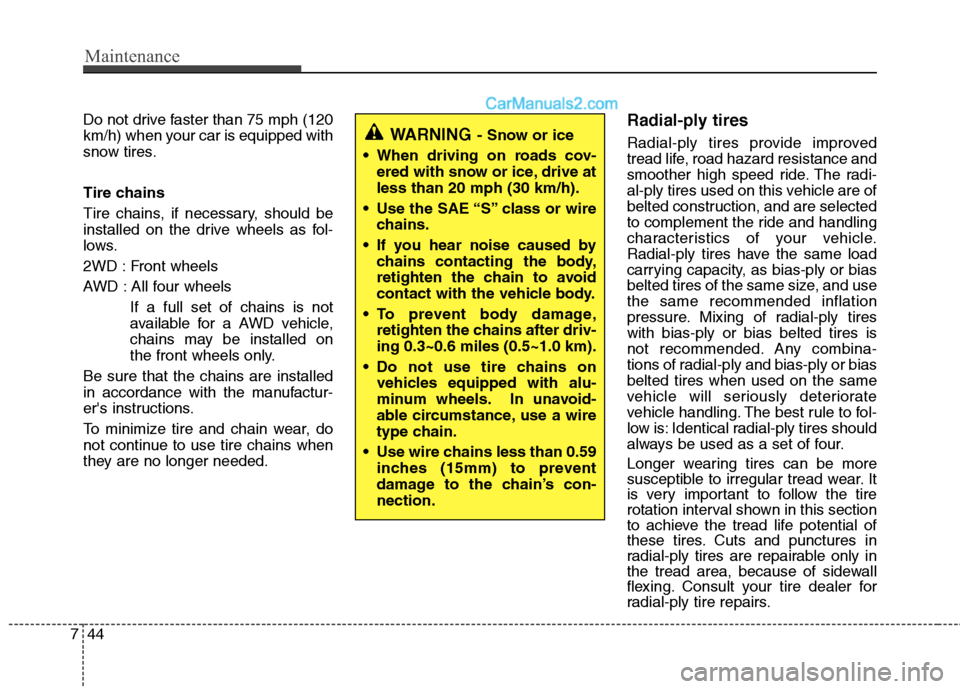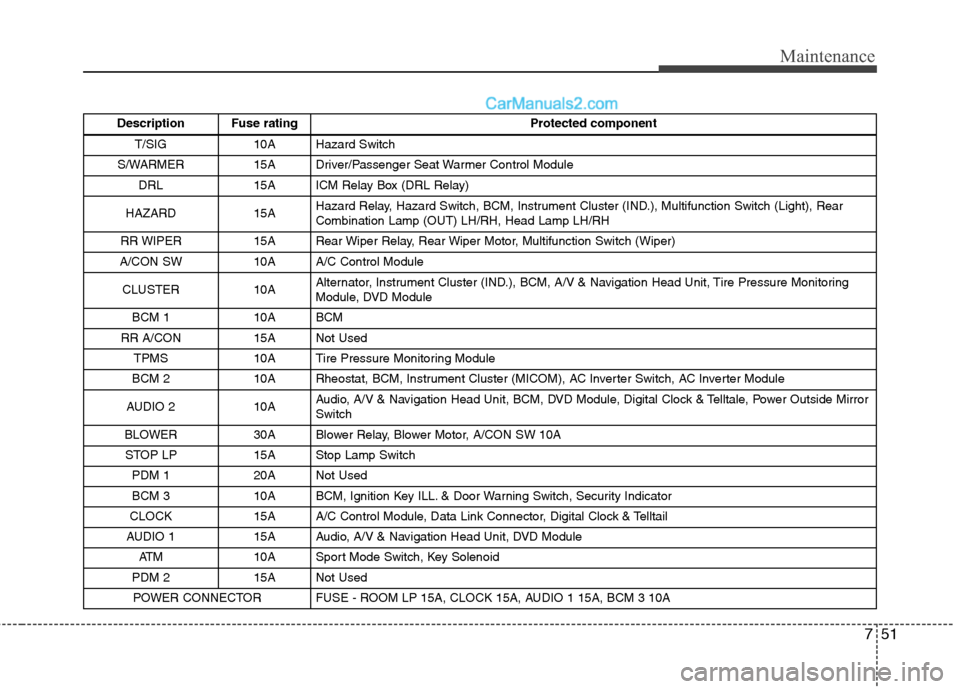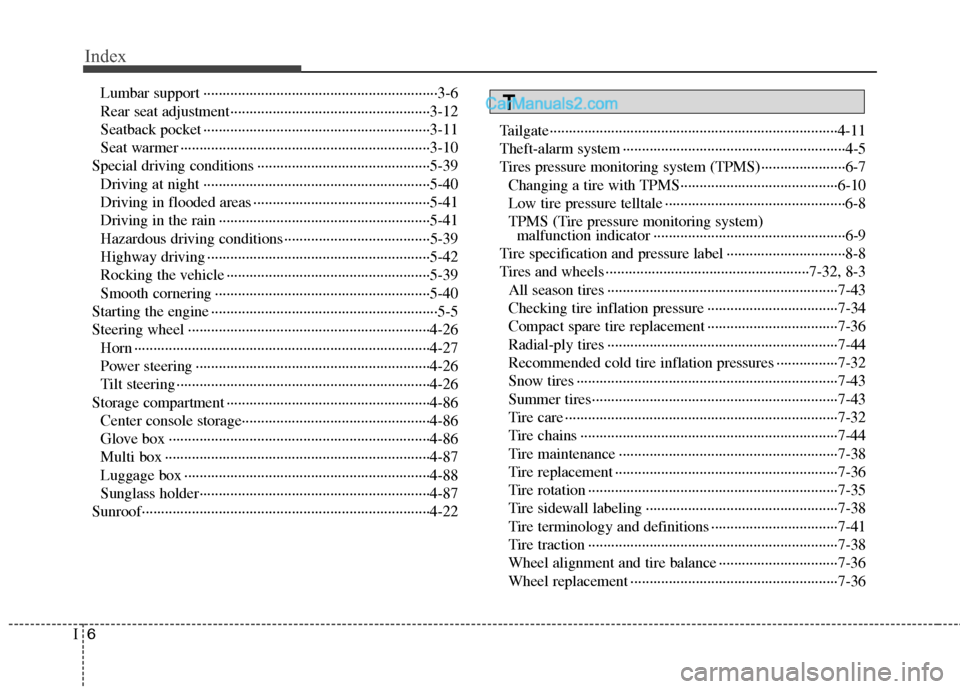2010 Hyundai Santa Fe Low tire pressure
[x] Cancel search: Low tire pressurePage 360 of 408

741
Maintenance
Traction - AA, A, B & C
The traction grades, from highest to
lowest, are AA, A, B and C. Those
grades represent the tires ability to
stop on wet pavement as measured
under controlled conditions on spec-
ified government test surfaces of
asphalt and concrete. A tire marked
C may have poor traction perform-
ance.
Temperature -A, B & C
The temperature grades are A (the
highest), B and C representing the
tire’s resistance to the generation of
heat and its ability to dissipate heat
when tested under controlled condi-
tions on a specified indoor laboratory
test wheel.
Sustained high temperature can
cause the material of the tire to
degenerate and reduce tire life, and
excessive temperature can lead to
sudden tire failure. Grades B and A
represent higher levels of perform-
ance on the laboratory test wheel
than the minimum required by the law.
G201100AEN
Tire terminology and definitions
Air Pressure: The amount of air
inside the tire pressing outward on
the tire. Air pressure is expressed in
pounds per square inch (psi) or kilo-
pascal (kPa).
Accessory Weight : This means the
combined weight of optional acces-
sories. Some examples of optional
accessories are, automatic transaxle
power seats, and air conditioning.
Aspect Ratio : The relationship of a
tire's height to its width.
Belt: A rubber coated layer of cords
that is located between the plies and
the tread. Cords may be made from
steel or other reinforcing materials.
Bead : The tire bead contains steel
wires wrapped by steel cords that
hold the tire onto the rim.
Bias Ply Tire : A pneumatic tire in
which the plies are laid at alternate
angles less than 90 degrees to the
centerline of the tread.
WARNING
The traction grade assigned to
this tire is based on straight-
ahead braking traction tests,
and does not include accelera-
tion, cornering, hydroplaning,
or peak traction characteristics.
WARNING - Tire temperature
The temperature grade for this
tire is established for a tire that
is properly inflated and not
overloaded. Excessive speed,
underinflation, or excessive
loading, either separately or in
combination, can cause heat
build-up and possible sudden
tire failure. This can cause loss
of vehicle control and serious
injury or death.
Page 363 of 408

Maintenance
44
7
Do not drive faster than 75 mph (120
km/h) when your car is equipped with
snow tires.
Tire chains
Tire chains, if necessary, should be
installed on the drive wheels as fol-
lows.
2WD : Front wheels
AWD : All four wheels
If a full set of chains is not
available for a AWD vehicle,
chains may be installed on
the front wheels only.
Be sure that the chains are installed
in accordance with the manufactur-
er's instructions.
To minimize tire and chain wear, do
not continue to use tire chains when
they are no longer needed.Radial-ply tires
Radial-ply tires provide improved
tread life, road hazard resistance and
smoother high speed ride. The radi-
al-ply tires used on this vehicle are of
belted construction, and are selected
to complement the ride and handling
characteristics of your vehicle.
Radial-ply tires have the same load
carrying capacity, as bias-ply or bias
belted tires of the same size, and use
the same recommended inflation
pressure. Mixing of radial-ply tires
with bias-ply or bias belted tires is
not recommended. Any combina-
tions of radial-ply and bias-ply or bias
belted tires when used on the same
vehicle will seriously deteriorate
vehicle handling. The best rule to fol-
low is: Identical radial-ply tires should
always be used as a set of four.
Longer wearing tires can be more
susceptible to irregular tread wear. It
is very important to follow the tire
rotation interval shown in this section
to achieve the tread life potential of
these tires. Cuts and punctures in
radial-ply tires are repairable only in
the tread area, because of sidewall
flexing. Consult your tire dealer for
radial-ply tire repairs.WARNING- Snow or ice
When driving on roads cov- ered with snow or ice, drive at
less than 20 mph (30 km/h).
Use the SAE “S” class or wire chains.
If you hear noise caused by chains contacting the body,
retighten the chain to avoid
contact with the vehicle body.
To prevent body damage, retighten the chains after driv-
ing 0.3~0.6 miles (0.5~1.0 km).
Do not use tire chains on vehicles equipped with alu-
minum wheels. In unavoid-
able circumstance, use a wire
type chain.
Use wire chains less than 0.59 inches (15mm) to prevent
damage to the chain’s con-
nection.
Page 370 of 408

751
Maintenance
Description Fuse ratingProtected component
T/SIG 10A Hazard Switch
S/WARMER 15A Driver/Passenger Seat Warmer Control Module DRL 15A ICM Relay Box (DRL Relay)
HAZARD 15A Hazard Relay, Hazard Switch, BCM, Instrument Cluster (IND.), Multifunction Switch (Light), Rear
Combination Lamp (OUT) LH/RH, Head Lamp LH/RH
RR WIPER 15A Rear Wiper Relay, Rear Wiper Motor, Multifunction Switch (Wiper)
A/CON SW 10A A/C Control Module
CLUSTER 10A Alternator, Instrument Cluster (IND.), BCM, A/V & Navigation Head Unit, Tire Pressure Monitoring
Module, DVD Module
BCM 1 10A BCM
RR A/CON 15A Not Used TPMS 10A Tire Pressure Monitoring Module
BCM 2 10A Rheostat, BCM, Instrument Cluster (MICOM), AC Inverter Switch, AC Inverter Module
AUDIO 2 10A Audio, A/V & Navigation Head Unit, BCM, DVD Module, Digital Clock & Telltale, Power Outside Mirror
Switch
BLOWER 30A Blower Relay, Blower Motor, A/CON SW 10A STOP LP 15A Stop Lamp Switch PDM 1 20A Not Used
BCM 3 10A BCM, Ignition Key ILL. & Door Warning Switch, Security Indicator
CLOCK 15A A/C Control Module, Data Link Connector, Digital Clock & Telltail
AUDIO 1 15A Audio, A/V & Navigation Head Unit, DVD Module ATM 10A Sport Mode Switch, Key Solenoid
PDM 2 15A Not Used POWER CONNECTOR FUSE - ROOM LP 15A, CLOCK 15A, AUDIO 1 15A, BCM 3 10A
Page 407 of 408

Index
6I
Lumbar support ··················\
··················\
··················\
·······3-6
Rear seat adjustment··················\
··················\
················3-12
Seatback pocket ··················\
··················\
··················\
·····3-11
Seat warmer ··················\
··················\
··················\
···········3-10
Special driving conditions ··················\
··················\
·········5-39
Driving at night ··················\
··················\
··················\
·····5-40
Driving in flooded areas ··················\
··················\
··········5-41
Driving in the rain ··················\
··················\
··················\
·5-41
Hazardous driving conditions ··················\
··················\
··5-39
Highway driving ··················\
··················\
··················\
····5-42
Rocking the vehicle ··················\
··················\
·················5-39\
Smooth cornering ··················\
··················\
··················\
··5-40
Starting the engine ··················\
··················\
··················\
·····5-5
Steering wheel ··················\
··················\
··················\
·········4-26 Horn ··················\
··················\
··················\
··················\
·····4-27
Power steering ··················\
··················\
··················\
·······4-26
Tilt steering ··················\
··················\
··················\
············4-26
Storage compartment ··················\
··················\
·················4-86\
Center console storage·············\
··················\
··················\
4-86
Glove box ··················\
··················\
··················\
··············4-86
Multi box ··················\
··················\
··················\
···············4-87
Luggage box ··················\
··················\
··················\
··········4-88
Sunglass holder··················\
··················\
··················\
······4-87
Sunroof··················\
··················\
··················\
··················\
···4-22 Tailgate··················\
··················\
··················\
··················\
···4-11
Theft-alarm system ··················\
··················\
··················\
····4-5
Tires pressure monitoring system (TPMS)··················\
····6-7
Changing a tire with TPMS··················\
··················\
·····6-10
Low tire pressure telltale ··················\
··················\
···········6-8
TPMS (Tire pressure monitoring system) malfunction indicator ··················\
··················\
··············6-9
Tire specification and pressure label ··················\
·············8-8
Tires and wheels ··················\
··················\
·················7-32\
, 8-3 All season tires ··················\
··················\
··················\
······7-43
Checking tire inflation pressure ··················\
················7-34
Compact spare tire replacement ··················\
················7-36
Radial-ply tires ··················\
··················\
··················\
······7-44
Recommended cold tire inflation pressures ················7-32
Snow tires ··················\
··················\
··················\
··············7-43
Summer tires··················\
··················\
··················\
··········7-43
Tire care ··················\
··················\
··················\
·················7-32\
Tire chains ··················\
··················\
··················\
·············7-44
Tire maintenance ··················\
··················\
··················\
···7-38
Tire replacement ··················\
··················\
··················\
····7-36
Tire rotation ··················\
··················\
··················\
···········7-35
Tire sidewall labeling ··················\
··················\
··············7-38
Tire terminology and definitions ··················\
···············7-41
Tire traction ··················\
··················\
··················\
···········7-38
Wheel alignment and tire balance ··················\
·············7-36
Wheel replacement ··················\
··················\
··················\
7-36T